Power and Noise
In terms of power consumption, we saw around 30W at idle without pluggable modules installed on 208V power and 31W on 120V power. The power supplies are 150W units and that ~120W delta provides plenty of power for the SFP+/ SFP28/ QSFP+ modules. Still, it is likely that the overall power consumption is going to be determined more by the type and quantity of modules used rather than the base switch itself.
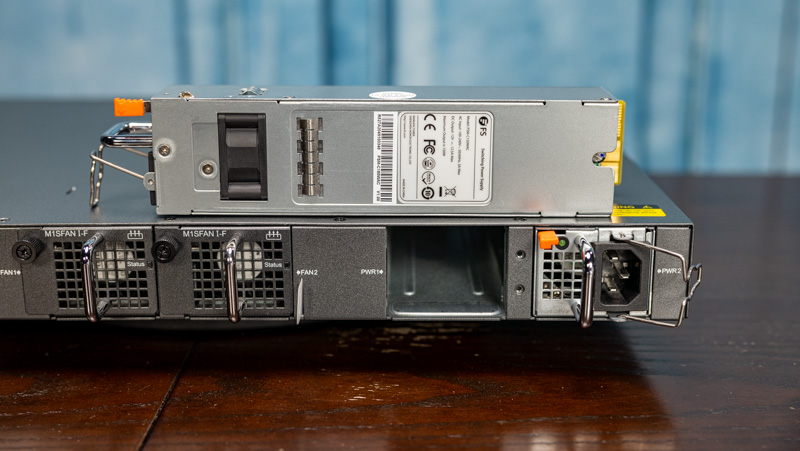
One other item we would like to have seen is that FS gets an efficiency rating on its power supplies. For example, if these were 80Plus Platinum or Gold PSUs, that would be a nice feature to market. We do not do power supply efficiency testing for switches, but most have some sort of efficiency rating.
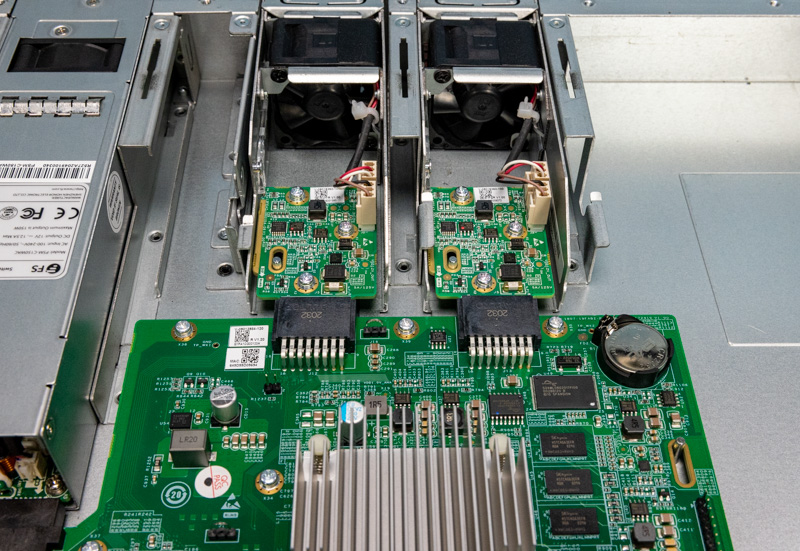
On noise, we measured around 42dba at 1M in front of the port side of the switch. That is nowhere near high-end switches, but it is also not extremely quiet. This is the type of switch that we would say to put in an equipment rack but not next to your desk.
Swapping the fan modules for more standard 4-pin PWM fans and doing a little ducting work to potentially make the switch quieter could open up potential use cases for 10GbE on office floors. Current noise levels are a bit too high even though they are not loud.
Final Words
Testing a switch from a new vendor is something we are always apprehensive about. FS does not have the same history in the market as some other well-known vendors. At the same time, by leveraging Broadcom’s software base, it seems as though FS was able to bring a reasonably well-featured switch to the market that even has features like a web interface.
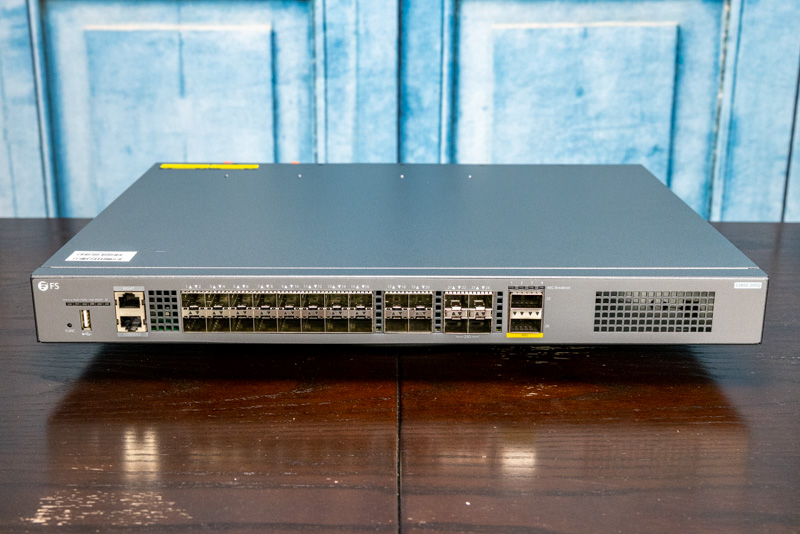
What is truly unique is the port count. With 20x SFP+, 4x SFP28, and 4x QSFP+ ports we have a solid mix of 10/25/40GbE networking. There are few switches in the market with this port count which is a differentiator itself.
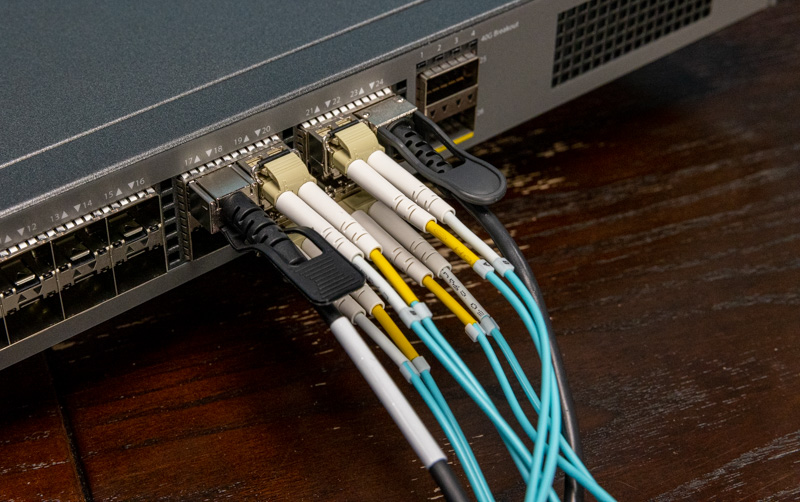
Probably the easiest way to understand the value proposition on this switch is when it comes to optics. FS has 25G 40km SFP28 modules for $819 which is very reasonable compared to many other options. Likewise, shorter range DACs and optics are relatively lower priced than solutions from Cisco and others. When using short-range DACs or optics, the price of the switch itself is around half of the total cost of the solution. Using longer-range options can make the pluggable portion cost more than the switch itself. This is well-known in the networking industry, and that may be why FS is making switches. It can provide a low-cost and compatible switch and optics solution.
Overall, we are not sure if this is a switch that is going to turn a Cisco customer into a FS customer in the large enterprise segment. For the SMB segment, FS seems to be on a good path and this certainly has a simple value proposition. We were pleasantly surprised that the FS S5860-20SQ offered more than we expected.


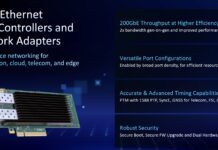
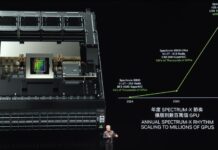
FS has great a selection of bare-metal switches from 10G all the way up to 400G. And all of them are extremely cheap compared to big vendors. It would be great if you could review some of them.
We’re considering going with their switches on a new project. Previously we used supermicro bare-metal switches. They worked great but they’re based on older broadcom chips that lack some important features and there’s not much to choose from anyway. One 10G and one 100G switch. FS has plenty to choose from.
It is nice to see some performance numbers and gui features, but I do miss feature testing in the networking reviews here.
I would have been very helpful to see what features it has and if they are actually working. Stacking, mlag, l3, dynamic routing, vrrp, stp, vlan and vlan in vlan, security, login possibilities (not just local accounts), logging, 802.1x features (although not that important for a ToR switch like this).
I have looked at FS.com switches for a while, but there is too little information around the web if the features really work and if it is stable or not…
Bought 2 of these switches about 6 months ago. So far they’ve worked flawlessly. We’re using them for L2 and light L3, with about 10 VLANS. No crashes, no problems so far. CLI is a Cisco clone. Web GUI is terrible. Beats not having one, but not by much. Obvious spelling errors, etc. No firmware updates posted on their website, at least not the last time I looked. Minor imperfections with syslog. Basically a good deal for the price, but the lack of firmware updates makes me nervous on how well they are maintaining their platform.
“On noise, we measured around 42W at 1M …”
I am guessing you mean dB? I use an 8 port 40 gig Mellanox IB switch at home, had to swap out its little jet engine fans to get some peace. So I was wondering about noise here. Thanks for reporting it!
An impressive switch, can someone suggest same configurations but instead of 16xSFP+, RJ45 10G Base T.
I know using SFP+ to RJ45 Copper Modules will add power overhead & heat. DO you thin it is a good idea to install Qty (10) of SFP+ to RJ45 Copper Modules to compenstae for the missing RJ45 ports
Thanks and advance
Def some stuff in video not here.
How do you compare this FS switch with cisco switch with similar price range/spec (say sx350x-24F) on performance prospective?
This video review by Patrick (STH) will certainly have me looking at this multi featured Very Hi Speed managed switch.
I have had in my network rack since 2017 an FS 24 gigabit port managed switch with 4 SFP+ combo ports. Was only like $160 back then in 2017. It hasn’t been retired yet because of 4 fiber connections. It is a very “easy to use” managed switch and supports link aggregation, too.
And I’ve used a few different transceivers in the SFP+ cages over the years and they have worked flawlessly.
I really like the FS website videos and they have been very helpful for me.
On another topic their 1Gb multi media converters are reasonably priced and work 24x7x365 without a hiccup.
So for my S&MB deployments FS for gigabit along with QNAP for hi speed 2.5 & 10Gb applications have become my mainstays.
Patrick thanks for the excellent review.
Since there are so many SPF+, etc cages, I’m thinking I would feel more confident from an expected heat generation standpoint to use fiber optic transceivers and limit my use of RJ45 TBase Transceivers.
Energy consumption (and thus heat) are different normally between the 10Gb transceivers types (fiber & TBase).
And STH has reviewed 10 Gb RJ45 TBase transceivers previously showing the similarities & differences.
It would be nice if the S5860-20SQ ran SONiC…
Would like to see a review of the FS N8550-32C which looks like a rebadged Edge-Core AS7726-32X.
I’m wondering about the converters too, I need 5-6 Base-T ports, not sure if that’s a problem in the power budget.
AKA – Ruijie Networks – RG-S6120-20XS4VS2QXS
I have the FS switch model S5500-48T8SP. Now sitting in storage because of the fan noise. I share an office with the wife, both working from home. These switch looking like Ruijie network switches. Have you reviewed any of the Ruijie Network switches?